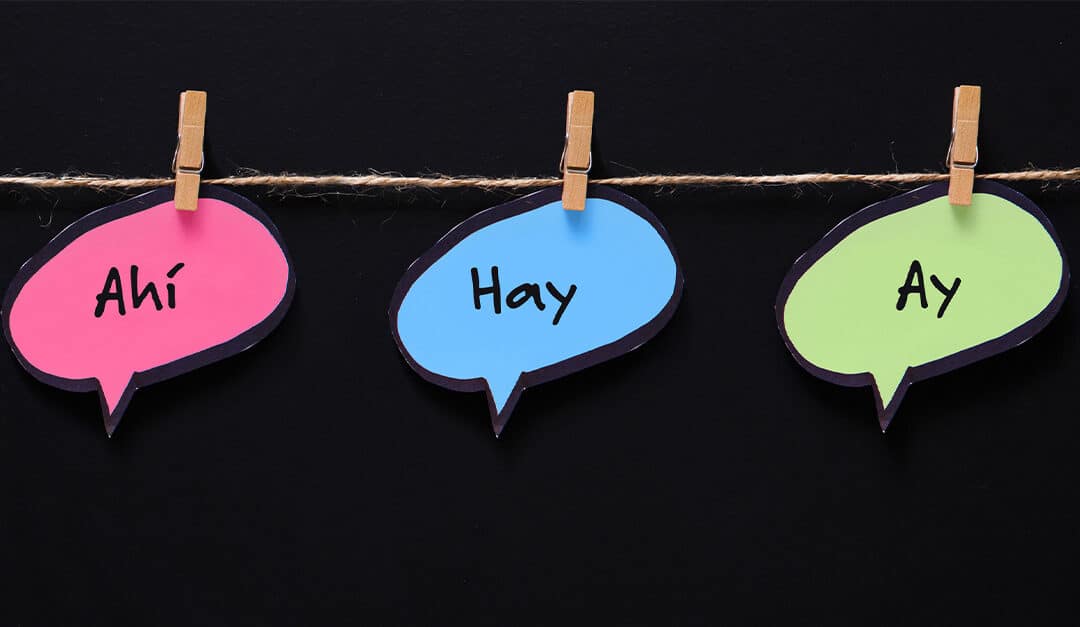Spanish is a super fun and very useful language to know. So, if you’re learning Spanish, congratulations! It’s a great investment in your present and future and in both your personal and professional life. We’re sure, you’ll thank yourself later.
But meanwhile, you might struggle with one or two things. And that’s understandable, because learning a completely different language is never easy.
One of the most confusing things in Spanish is the differences between “ahí”, “hay” and “ay”. Because they sound similar and are written sharing some of the same letters. Want to know a secret? Sometimes, even native speakers have a hard time with these.
So, if you’re also having trouble with this topic, today is your lucky day. Here’s TruFluency’s guide to understand the different meanings and uses of these tricky words.
Ahí
First off, we have “ahí”.
It can be confusing to write, because as you can see, it has an accent mark on the “i”. It’s important you learn this, because that accent mark can’t go in any other letter of this word. Because it means that the strongest sound of the word falls on that “i”.
It also has an “h” in the middle. It’s important to tell you that in Spanish the “h” doesn’t sound. So, you don’t have to pronounce it in this word.
That being said, “ahí” sounds like “ah ee”. See? It sounds stronger when pronouncing the “ee” (“í”). All because of the accent mark. But what does “ahí” mean? This is an adverb of place. So it’s used to indicate a place. It’s like “there”.
For example:
- ¿Dónde está mi portafolio? – Está ahí. / Where’s my briefcase? – It’s there.
- ¿En dónde pusiste las llaves de mi coche? – Ahí las puse, sobre la mesa. / Where did you put my car keys? – I put them there, on the table.
- Ya nos fuimos de ahí. / We already left there.
- ¡Ahí estaba mi celular! ¡Lo estuve buscando todo el día! / There was my cellphone! I’ve been looking for it the whole day!
If you still have trouble with this word, you can change it for “allí” (over there) or “aquí” (here) to see if you’re using it correctly. Though they don’t have the exact same meaning, these are other adverbs of place.
So, if you can use “allí” or “aquí” in your sentence, then you’re using the “ahí” correctly.
For example:
- ¿Dónde está mi portafolio? – Está allí.
- ¡Aquí estaba mi celular!
Hay
It’s time for “hay”.
Here, we also have an “h”, but it’s at the beginning of the word. And like we told you above, unlike in English, the “h” in Spanish doesn’t sound, no matter where in the word it is.
This “hay” also has a “y” instead of an “i” and there’s no accent mark, so no need to worry about that. Uff! Therefore, this word is pronounced just like the interjection “ay”.
“Hay” comes from the verb “haber” (to be / to have), and it’s used as “there is / there are”.
For example:
- ¿Hay refresco? / Is there soda?
- Ya no hay cervezas. / There are no beers anymore.
- Hay un nuevo jefe en la oficina. / There is a new boss at the office.
- Mire, en el escritorio hay un reconocimiento para usted por ser el empleado del mes. / Look, on the desk there’s a recognition for you for being the employee of the month.
But wait, you can also use “hay” as “have to”. For this you just have to add a “que” after the “hay”.
- No hay que mentir. / No need to lie. / You/We don’t have to lie.
- Sarah se cayó, hay que ayudarla. / Sarah fell, we have to help her.
- Hay que confiar en nosotros mismos. / We have to trust in ourselves.
- Cariño, nuestro perro se hizo pipí en el patio de los vecinos, hay que disculparnos con ellos. / Honey, our dog peed on the neighbors’ yard, we have to apologize to them.
Ay
And now, we have “ay”, which you might already know.
This one is written with a “y”, just like “hay”. But it doesn’t have an “h”. And because it is pronounced as an exclamation, it has to go accompanied by exclamation marks.
It is also pronounced just like “hay”, so “ay”.
Okay, and what is it used for? It is an interjection used to express worry, shock, pain, surprise, sorrow or even relief. That’s why we told you maybe you already knew it and maybe have even used it. Though in English, it’s considered archaic, because it’s not used as commonly as before anymore.
But maybe you’ve heard a Spanish speaker use it. Because in Spanish it’s very common to say it out loud in all kinds of situations.
For example:
- ¡Ay! Ese señor casi choca su auto. / Ouch! That man almost crashes his car.
- ¡Ay! ¡Me pegué en el codo! / Ay, I hit myself in the elbow!
- ¡Boo! – ¡Ay! ¡Me espantaste! No vuelvas a hacer eso nunca más. / Boo! – Ah, you scared me, don’t do that ever again.
- ¡Ay! ¡No lo puedo creer! / Oh! I can’t believe it!
- ¡Ay, no! Mi equipo favorito perdió el partido de fútbol. / Oh no! My favorite team lost the soccer match.
- ¿Hiciste lo que te pedí? ¿No? Ay, olvídalo. / Did you do what I asked you to? No? Oh, forget it.
- ¡Ay! Qué bueno que encontraste a tu perro. / Uff! So good that you found your dog.
Mnemonic Sentences for Ahí, Hay and Ay
A great way to remember the right grammar and use of these three words is by using mnemonic sentences. Mnemonic is any kind of technique used to help you memorize something more easily. So, here are some sentences we came up with that combine these three words to help clear any confusion:
- ¡Ay, no! Ahí van unos ladrones a robar el dinero que hay en el banco. / Oh no! There go some thieves to steal the money that there’s in the bank.
- ¡Ay! Qué bueno que sí hay botes de basura ahí en el nuevo parque. / Oh! It’s so good that there are trash cans there in the new park.
- ¡Ay! Los fantasmas que hay ahí me espantaron horrible. / Ah! The ghosts that there are there scared me horribly.
- ¡Ay, cuidado! Ahí hay hoyos. / Ah, careful! There are holes there.
- Hay cinco perros jugando en el jardín. ¡Ay! Desapareció uno. ¡Ay! ¡Ahí está! Jugando con mi corbata. / There are five dogs in the garden. ¡Ah! One disappeared. Oh! There it is! Playing with my tie.
- ¡Ay! Había olvidado que ahí hay fruta. / Oh! I’d forgotten there was fruit there.
Practice Your Spanish with TruFluency
Are you ready to put into practice the “ahí”, “hay” and “ay”? Good! Do it with TruFluency Spanish classes.
Thanks to our Bellieu Method, we have speaking practice in every lesson. That’s the best way you’ll achieve language fluency and that’s what we want. For you to communicate in Spanish fluently and properly.
So, have no doubt that during our classes, you’ll be able to practice the new words you learned in today’s blog. You just have to say them out loud in a sentence every now and then when it’s your turn to speak.
But that’s not it. We also have native teachers who will customize the classes to your needs, so you can achieve all your language goals! So hey, do you want to work on your pronunciation of the words “ahí”, “hay” and “ay”? Cool, we got you. Or do you want to clarify any other Spanish doubts? Tell us, we’ll help you!
Don’t waste any time and take a two-hour trial class now divided into two sessions of one hour! The first class will be about your needs and goals. You can choose your schedule, because we have flexible scheduling. ¡Verás que aquí tenemos las mejores clases de español!





